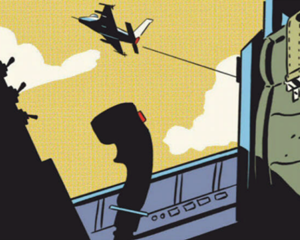Though dogfighting practice, like parade-ground drill and military bands, is a leftover from an earlier form of warfare that still serves a residual purpose, the next phase of DARPA's ACE(AIr combat evolution) project belongs firmly in the future, for it will require the piloting programs to control two planes simultaneously. Also, these virtual aircraft will be armed with short-range missiles rather than guns. That increases the risk of accidental fratricide, for a missile dispatched towards the wrong target will pursue it relentlessly. Tests after that will get more realistic still, with longer-range missiles, the use of chaff and flares, and a requirement to deal with corrupt data and time lags of a sort typical of real radar information.
盡管空戰像閱兵式地面演練和軍樂隊那樣是舊戰爭的殘留物,但它仍有其殘存的作用。未來DARPA的“空戰進化(ACE)”項目將要進入下一階段,屆時會要求飛行員同時控制兩架飛機。此外,這些虛擬飛機將配備短程導彈而不是槍炮,這增加了意外發生自相殘殺的風險,因為朝錯誤目標發射的導彈會無情地追擊敵人。之后的測試還將更加真實,包括遠程導彈、箔條和信號彈的使用以及處理一種真實雷達信息典型的數據破壞和時間滯后的要求。
The point of all this, putative Top Guns should be reassured, is not so much to dispense with ilots as to help them by "a redistribution of cognitive workload within the cockpit", as Colonel Javorsek puts it. In theory, taking the pilot out of the plane lets it manoeuvre without regard for the impact of high g-forces on squishy humans. An uncrewed plane is also easier to treat as cannon-fodder. Still, most designs for new fighter jets have not done away with cockpits. For example, both of the rival European programmes—the British-led Tempest and the Franco-German-Spanish Future Combat Air System (FCAS)—are currently "optionally manned". There are several reasons for this, explains Nick Colosimo, a lead engineer at BAE Systems, Tempest's chief contractor.
那些“空中英豪們”應該放下心來,因為正如亞沃爾塞克上校所說,所有這一切的意義并不在于撤掉飛行員,而在于通過“重新分配駕駛艙內的認知負荷”來為他們提供幫助。理論上說,讓飛行員離開飛機就是在無需考慮高重力對軟綿綿的人體的影響的情況下來操縱飛機。一架無人飛機也更容易被當作炮灰。盡管如此,大多新型戰斗機的設計里并沒有去掉駕駛艙。例如,歐洲的兩個競爭項目——英國主導的“害蟲”和法國-德國-西班牙的未來作戰空中系統(FCAS)——目前都是“可選載人”的。對此有幾點原因,“害蟲”的總承包商、BAE系統的首席工程師尼克·科洛西莫解釋說。

One is that eliminating the pilot does not provide much of a saving. The cockpit plus the assorted systems needed to keep a human being alive and happy at high altitude—cabin pressure, for example—contribute only 1-2% of a plane's weight. A second is that even AI systems of great virtuosity have shortcomings. They tend not to be able to convey how they came to a decision, which makes it harder to understand why they made a mistake. They are also narrowly trained for specific applications and thus fail badly when outside the limits of that training or in response to "spoofing" by adversaries.
第一點是撤掉飛行員節省不了多少錢。在高海拔環境下(比如機艙壓力),駕駛員座艙和各種系統只占飛機重量的1-2%。第二點,即便是技術精湛的人工智能系統也有缺點。他們通常無法表達自己是如何做出決定的,這使得人們更難理解他們犯錯的原因。它們還為特定的應用進行了嚴格的訓練,所以當情況超出了訓練的范圍或者應對敵方的“詐術”時,它們會敗得很慘。
An example of this inflexibility is that, at one point in the AlphaDogfight trials, the organisers threw in a cruise missile to see what would happen. Cruise missiles follow preordained flight paths, so behave more simply than piloted jets. The AI pilots struggled with this because, paradoxically, they had beaten the missile in an earlier round and were now trained for more demanding threats. "A human pilot would have had no problem," observes Chris DeMay, who runs the APL's part of ACE. "AI is only as smart as the training you give it."
這種僵化的一個例子是,在“阿爾法空戰”的庭審中,組織者曾投了一枚巡航導彈看看會發生什么。巡航導彈遵循預定的飛行路線,表現得比人工駕駛飛機更為簡單。而這種情況對人工智能飛行員來說會很棘手,因為它們在之前的回合中已經擊敗了導彈,現在它們被訓練應對的是更為嚴峻的威脅,這很矛盾。“人類飛行員不會有任何問題,”負責空戰進化(ACE)項目APL部分的克里斯·戴梅說。“人工智能的聰明程度取決于你給它的訓練。”
譯文由可可原創,僅供學習交流使用,未經許可請勿轉載。











